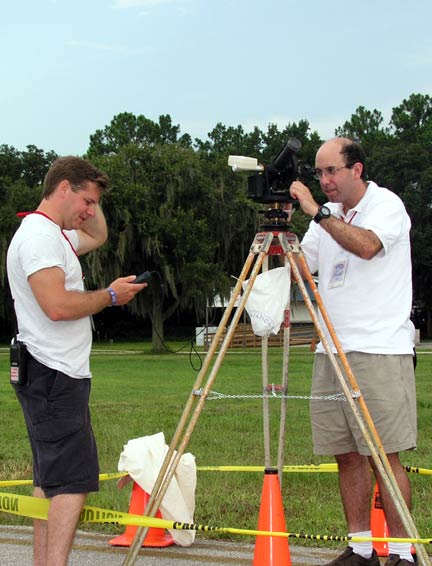The WINDSOCK and Warren-Knight (David White) Pilot Balloon Hybrid

(Alex Belov and Martin Brenner tracking a balloon at WAC2003)
The Windsock Electronic Theodolite and Windsock system were added to a conventional theodolite to create a hybrid system. This system was used at the World Aerobatics Championships in Lakeland Florida with great success. International regulations require wind speed and direction measurement by Pilot Balloon or local Doppler Radar. Pilot Balloon measurement was utilized in Lakeland. Often these measurements are taken every 30 minutes. The use of the windsock allowed continuous tracking of the balloon ascents without having to read the azimuth and elevation scales and micrometers on the theodolite. As a result even in some fairly high wind conditions with complex profiles, no balloons were lost over the 10 days of pilot balloon operations. Wind profiles were available within seconds of the termination of tracking, without the possibility of scale reading errors, or data entry errors by the meteorological team.
The conventional theodolite platform afforded an ideal setup to track the balloon. In addition the theodolites scales and micrometer drums provided a backup method of obtaining azimuth and elevation information and verified the accurate operation of the Windsock Electronics. The theodolites scales could be compared to the Windsock's readout at any time to verify the proper operation of the electronic compass and inclinometer. This verification was done before and after every ascent at WAC. The accuracy was also checked occasionally during the ascent. During pre-event testing we discovered that the wood deck that we had planned to operate on had iron trusses that created a magnetic field degraded the performance of the Windsock. The theodolite was relocated before competition flights were scheduled.
A major advantage of this system is that it allows single person pilot balloon operation when required.

Traditional Optical Electronic Theodolites are available from a few manufacturers. With the exception of the sporadically available1 Windsway "Windreader" electronic theodolite system (approximate cost $ 5,500), electronic theodolites cost in the neighborhood of $ 16,000.00 each. The principal advantage of traditional pilot balloon theodolites over the fully configured Windsock System is their facility for the user to track the balloon as well accuracy and stability of azimuth and elevation information derived from them.
The traditional optical theodolite design has the advantage of a stable level platform, bent axis telescope, etc. It is the optimal platform for accurately following a balloon's ascent. Typically these instruments can easily follow the track of a balloon for thousands of feet and many minutes to a repeatable accuracy of better than 1/10 of a degree (elevation and azimuth).
Micrometer Drums (and encoders in the case of expensive electronic theodolites) are more accurate than the 2 axis electronic compass and accelerometer systems used in the Windreader or the 3 axis compass and tilt compensated 2 axis inclinometer used in the Windsock Electronic Theodolite.
INNOVATIONS OF THE WINDSOCK
The Windsock allows timing of ascents and easy processing of the observation results through manual entry of observations made with a conventional pibal theodolite. However making observations is still difficult because readings have to be taken from the theodolite written down, then keyed into Windsock for processing. Adding the Electronic Theodolite sensor package to a traditional theodolite automates this process with a small loss in accuracy due to the higher accuracy of micrometer drums versus the sensors in the Winsock Electronic Theodolite. The accuracy difference may not be significant for many users such as hot air balloonists and sport aircraft.
The addition of affordable electronics to a conventional pilot balloon theodolite was a strength of the Windsway Windreader System. I felt that adding the Windsock and Windsock Electronic Theodolite to a high quality surplus American theodolite would create an affordable (under $ 5,000) superior quality pilot balloon theodolite system. The photos above is the result of the design of that system. The addition of the system does not require extensive modification of the theodolite itself (only remanufacturing of the trunion cap) and no modifications to the Windsock components (adding a bracket which mates with the new trunion cap). Special thanks to James A. Long (an artist with a Lathe and Milling machine) for engineering and producing a great bracket system. In addition the Theodolite's compass must be removed (to prevent Magnetic interference with the Windsock's sensors).
1A series of Windreader models were produced up to 1999 in small numbers. These were well received in the ballooning community as well as some other applications. I do not believe that any have been manufactured since then. See the Windsway Web site for product availability or future product announcements.
